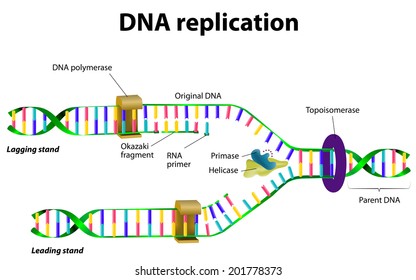DNA carries genetic information. So during cell division DNA also replicates to carry genetic information to the newly formed cell. Watson and Crick proposed the DNA replication scheme.
ATGC is an acronym for the four types of bases found in a DNA molecule: adenine (A), thymine (T), guanine (G) and cytosine (C) . Adenine pairs with thymine, and cytosine pairs with guanine.
Replication :
It occurs at the S-phase of the cell cycle.
Origin of replication : An origin of replication is a sequence of DNA at which replication is initiated. Porkaryotes have single origin of replication but eukaryotes have several thousands origins of replication.
Activation of deoxyribonucleotides : Deoxyribonucleotides are activated by phosphate and converted to triphosphate state. They provide energy for polymerisation reaction.
Unwinding of helix : The double helical DNA unwinds by the help of enzyme helicase. Later it forms Y shaped structure called replication fork. The unwinded single strands are stabilised by the help of single strand binding proteins. After unwinding supercoiling gets developed on the end of DNA and this tension is released by the enzyme topoisomerase.
Formation of primer strand : primers are short strands of RNA. A primer is synthesized by an enzyme called primase, which is a type of RNA polymerase, before DNA replication can occur.
Elongation of new strand : During elongation, an enzyme called DNA polymerase adds DNA nucleotides to the 3′ end of the newly synthesized polynucleotide strand. These small neucleotides are caled Okazaki fragments. When replication polarity is 3` -> 5`, it's called leading daughter strand and when 5` -> 3` it's called lagging daughter strand. The termination occurs by an enzyme RNAase H which removes the RNA primer from the beginning of the Okazaki fragments. Then they are joined by enzyme called DNA ligase to form a complete strand.
Enzymes Involved In DNA Replication
DNA replication is a highly enzyme-dependent process. There are many enzymes involved in the DNA replication which includes the enzymes DNA-dependent DNA polymerase, helicase, ligase, etc. Among them, DNA-dependent DNA polymerase is the main enzyme.
DNA-dependent DNA polymerase
It helps in the polymerization and catalyzes and regularises the whole process of DNA replication with the support of other enzymes. Deoxyribonucleoside triphosphates are the substrate as well as the energy provider for the replication process. DNA polymerase is of three types:
DNA Polymerase I
It is a DNA repair enzyme. It is involved in three activities:
- 5′-3′ polymerase activity
- 5′-3′ exonuclease activity
- 3′-5′ exonuclease activity
DNA Polymerase II
It is responsible for primer extension and proofreading ( ATGC links ).
DNA Polymerase III
It is responsible for in vivo DNA replication.
Helicase
Helicase is the enzyme which unzips the DNA strands by breaking the hydrogen bonds between them. Thus, it helps in the formation of the replication fork.
Ligase
Ligase is the enzyme which glues the discontinuous DNA strands ( okazaki fragmaents ).
Primase
This enzyme helps in the synthesis of RNA primer complementary to the DNA template strand.
Endonucleases
These produce a single-stranded or a double-stranded cut in a DNA molecule.
Single-stranded Binding Proteins
It binds to single-stranded DNA and protects it from forming secondary structures.
Attend the quiz ⏬⏬⏬
All zoology quiz links page ⏬⏬⏬

0 Comments